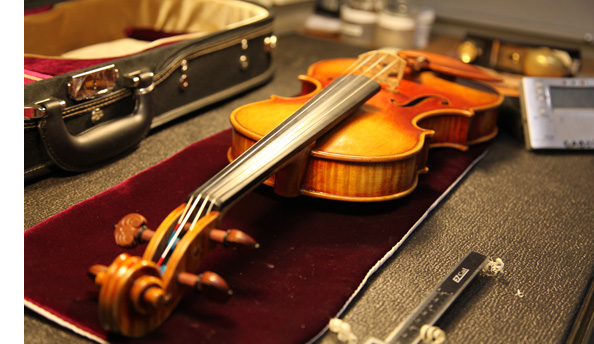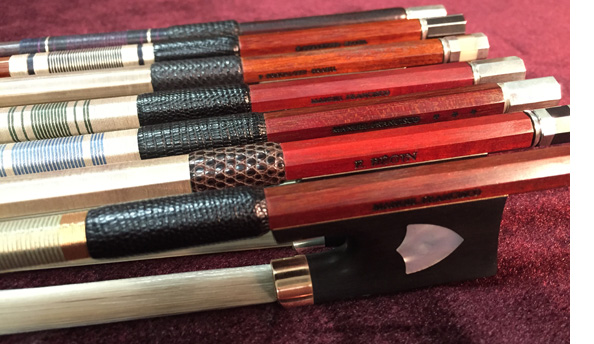Your shopping cart is currently empty. Please select the items you would like to purchase from our catalog.
General Care and Maintenance
Instrument Care

- As a general rule of thumb, treat the instrument as a person. What is uncomfortable for you is also uncomfortable for it.
This means that leaving the instrument in the car for any period of time, winter or summer, can be fatal for the instrument.
In the winter time, due to the extreme cold, the instrument could easily crack, and in the summer time, due to the heat, the
instrument’s varnish can quickly melt or the glue holding the instrument together can soften and lose its adhesive properties.
Any drastic change in temperature from cold to hot or vice versa can also lead to extensive damage.
- Humidity also plays a role in the instruments well being. When traveling to arid or dry climates, moisture should be
given to the instrument by means of a damp-it or case humidifier to prevent the wood from drying out and cracking.
Humidifying the instrument on a regular basis is only necessary if one is living in an area with low humidity levels.
- Inside violin familyinstruments, there is a small wooden stick called the soundpost. The soundpost is designed to help
transfer vibrations from the bridge and top to the back of the instrument. It also serves a
secondary purpose of keeping the tension applied to the top of the
instrument from the strings and bridge from crushing the top of the
instrument. In the event of the
soundpost falling, it is important that the strings be loosened immediately
to prevent any damage to the top of the instrument.
- Each time the instrument is played, the excess rosin left from the bow should be removed
with a soft cleaning cloth. If
rosin is not removed from the surface of the instrument, it can become embedded in the varnish and interfere with the vibrations in the top of
the instrument, thus adversely affecting tone. It is also unattractive. Using most
household cleaners will destroy your instruments
varnish. Never allow
alcohol to get near the varnish as it will destroy it. It is safest not to use alcohol at all.
The only safe household cleaner to use is Simple Green which is
safe on strings and varnish.
Never use a furniture polish on your instrument.
Furniture polishes usually contain lemon oil and/or silicone
which can damage an instrument’s varnish.
- Never
put stickers on
the body of the instrument. While
it is fine to put stickers on the neck and fingerboard, stickers placed on
the body of the violin can severely damage the violin’s varnish.
- Periodically, strings
will need to be replaced. Strings
need replacing when they become false, begin to unwind, or break. Consult you teacher if you are not able
to distinguish if a string is false or not. As a beginner, it is best to let the teacher tune the
instrument; it is very easy to break strings when one is inexperienced in tuning and attempts to do so. When ordering replacement strings, it is
helpful for the customer to know what brand of string is preferred along
with which specific string is needed.
- When tuning, it is
important to check the bridge for any warping that has occurred due to the
tension of the strings pulling it back and forth. If the bridge is warped, it should be
replaced. Ideally the back of the bridge should form a 90°
angle with the top of the instrument. If it does not, take it to your teacher
or the violin shop and have it adjusted.<

Bow Care
When a student is ready to upgrade
their bow from a fiberglass to a brazilwood, carbon fiber, or pernambuco bow, it is important to be mindful of bow care and maintenance. These tips
will help you to understand how best to care for your bow and to avoid problems in the future.
- Always loosen
your bow when you have finished playing. Leaving the bow hair under tension can cause your stick to warp and the bow hair to stretch out.
Once the hair is stretched, the bow will no longer tighten up to playing tension and will need to be rehaired.
- At least once a
year it is necessary to rehair your bow to maintain optimal sound. The hair on your bow is made from horse hair and wears out over time
and use. Bows which have old hair tend to slide on the string and require more and more rosin to function which results in a less than
satisfying tone.
- It is also important to protect the tip of your bow from damage through
an impact. Most bows have a bone or imitation ivory tip covering the wood or carbon fiber protecting it from damage
to the shaft itself. This bone tip also plays a part in keeping the hair secure. When this tip is cracked or broken off, the
wedge holding the hair will be much more likely to come loose. Replacing this bone tip which is custom made for each bow can be costly
and requires rehairing the bow as well.
- Refrain from directly
touching the bow hair. Dirt and oils on the hands damage the
playability of bow hair and increase the frequency at which your bow will need to be rehaired. It is best to wash your
hands before you play your instrument to avoid the transmission of oil and dirt from the hand of the player to the strings, instrument,
and bow.
Instrument Care

- As a general rule of thumb, treat the instrument as a person. What is uncomfortable for you is also uncomfortable for it. This means that leaving the instrument in the car for any period of time, winter or summer, can be fatal for the instrument. In the winter time, due to the extreme cold, the instrument could easily crack, and in the summer time, due to the heat, the instrument’s varnish can quickly melt or the glue holding the instrument together can soften and lose its adhesive properties. Any drastic change in temperature from cold to hot or vice versa can also lead to extensive damage.
- Humidity also plays a role in the instruments well being. When traveling to arid or dry climates, moisture should be given to the instrument by means of a damp-it or case humidifier to prevent the wood from drying out and cracking. Humidifying the instrument on a regular basis is only necessary if one is living in an area with low humidity levels.
- Inside violin familyinstruments, there is a small wooden stick called the soundpost. The soundpost is designed to help transfer vibrations from the bridge and top to the back of the instrument. It also serves a secondary purpose of keeping the tension applied to the top of the instrument from the strings and bridge from crushing the top of the instrument. In the event of the soundpost falling, it is important that the strings be loosened immediately to prevent any damage to the top of the instrument.
- Each time the instrument is played, the excess rosin left from the bow should be removed with a soft cleaning cloth. If rosin is not removed from the surface of the instrument, it can become embedded in the varnish and interfere with the vibrations in the top of the instrument, thus adversely affecting tone. It is also unattractive. Using most household cleaners will destroy your instruments varnish. Never allow alcohol to get near the varnish as it will destroy it. It is safest not to use alcohol at all. The only safe household cleaner to use is Simple Green which is safe on strings and varnish. Never use a furniture polish on your instrument. Furniture polishes usually contain lemon oil and/or silicone which can damage an instrument’s varnish.
- Never put stickers on the body of the instrument. While it is fine to put stickers on the neck and fingerboard, stickers placed on the body of the violin can severely damage the violin’s varnish.
- Periodically, strings will need to be replaced. Strings need replacing when they become false, begin to unwind, or break. Consult you teacher if you are not able to distinguish if a string is false or not. As a beginner, it is best to let the teacher tune the instrument; it is very easy to break strings when one is inexperienced in tuning and attempts to do so. When ordering replacement strings, it is helpful for the customer to know what brand of string is preferred along with which specific string is needed.
- When tuning, it is important to check the bridge for any warping that has occurred due to the tension of the strings pulling it back and forth. If the bridge is warped, it should be replaced. Ideally the back of the bridge should form a 90° angle with the top of the instrument. If it does not, take it to your teacher or the violin shop and have it adjusted.<

Bow Care
When a student is ready to upgrade their bow from a fiberglass to a brazilwood, carbon fiber, or pernambuco bow, it is important to be mindful of bow care and maintenance. These tips will help you to understand how best to care for your bow and to avoid problems in the future.- Always loosen your bow when you have finished playing. Leaving the bow hair under tension can cause your stick to warp and the bow hair to stretch out. Once the hair is stretched, the bow will no longer tighten up to playing tension and will need to be rehaired.
- At least once a year it is necessary to rehair your bow to maintain optimal sound. The hair on your bow is made from horse hair and wears out over time and use. Bows which have old hair tend to slide on the string and require more and more rosin to function which results in a less than satisfying tone.
- It is also important to protect the tip of your bow from damage through an impact. Most bows have a bone or imitation ivory tip covering the wood or carbon fiber protecting it from damage to the shaft itself. This bone tip also plays a part in keeping the hair secure. When this tip is cracked or broken off, the wedge holding the hair will be much more likely to come loose. Replacing this bone tip which is custom made for each bow can be costly and requires rehairing the bow as well.
- Refrain from directly touching the bow hair. Dirt and oils on the hands damage the playability of bow hair and increase the frequency at which your bow will need to be rehaired. It is best to wash your hands before you play your instrument to avoid the transmission of oil and dirt from the hand of the player to the strings, instrument, and bow.





